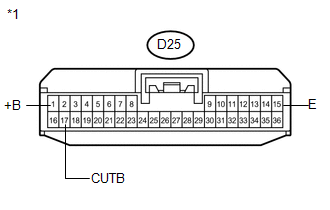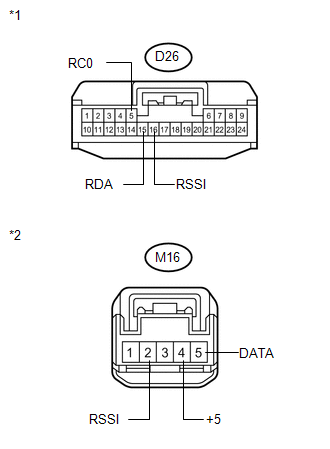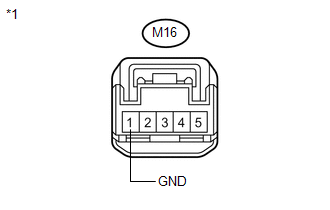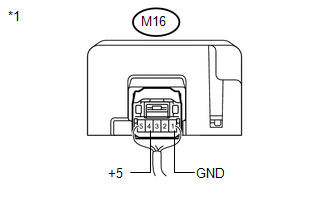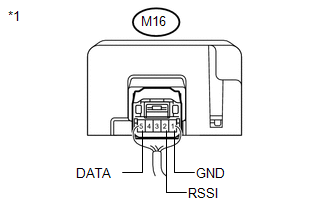Toyota Venza: All Door Entry Lock/Unlock Functions and Wireless Functions do not Operate
DESCRIPTION
When the entry door lock and unlock functions and wireless door lock and unlock functions do not operate, radio wave interference, or a malfunction in the key or signal circuit between the door control receiver assembly and certification ECU (smart key ECU assembly) is suspected. The signal circuit is shared by the entry function and wireless door lock function.
WIRING DIAGRAM
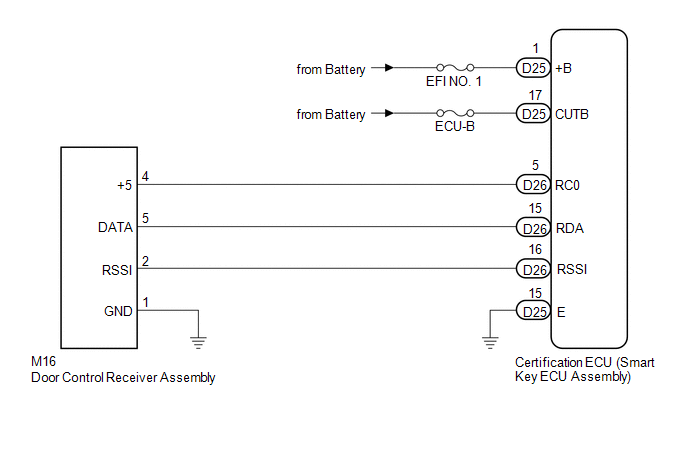
CAUTION / NOTICE / HINT
NOTICE:
- The smart key system (for entry function) uses a multiplex communication
system (LIN communication system) and CAN communication system. Inspect
the communication function by following How to Proceed with Troubleshooting
(See page
.gif) ). Troubleshoot the smart
). Troubleshoot the smart
key system (for entry function) after confirming that the communication system is functioning properly. - Before performing the inspection, check that DTC B1242 (wireless door
lock control) is not output (See page
.gif)
). - Confirm that another key is not in the cabin.
PROCEDURE
|
1. |
CHECK POWER DOOR LOCK OPERATION |
(a) When the door control switch on the master switch assembly is operated, check
that the doors unlock and lock according to switch operation (See page
.gif) ).
).
OK:
Door locks operate normally.
| NG | .gif) |
GO TO POWER DOOR LOCK CONTROL SYSTEM (Proceed to Problem Symptoms Table) |
|
|
2. |
CHECK ELECTRICAL KEY TRANSMITTER |
(a) Check if another registered key is available.
|
Result |
Proceed to |
|---|---|
|
Another registered key is not available. |
A |
|
Another registered key is available. |
B |
| B | .gif) |
GO TO STEP 4 |
|
|
3. |
REGISTER ELECTRICAL KEY TRANSMITTER |
(a) Register a new key (See page .gif) ).
).
|
|
4. |
CHECK ELECTRICAL KEY TRANSMITTER (OPERATION) |
(a) Using the key registered in the previous step or another registered key,
check that the entry function operates normally (See page
.gif) ).
).
OK:
Entry function operates normally.
| NG | .gif) |
GO TO STEP 7 |
|
|
5. |
CHECK ELECTRICAL KEY TRANSMITTER (LED) |
(a) Check that the transmitter LED illuminates each time when the switch is pushed 3 times.
|
Result |
Proceed to |
|---|---|
|
Transmitter LED does not illuminate at all when switch is pushed 3 times. |
A |
|
Transmitter LED illuminates each time when switch is pushed 3 times. |
B |
|
Transmitter LED does not illuminate the second or third time. |
C |
HINT:
If the transmitter LED does not illuminate the second or third time, replace the transmitter battery as it is depleted.
| B | .gif) |
REPLACE ELECTRICAL KEY TRANSMITTER |
| C | .gif) |
REPLACE TRANSMITTER BATTERY |
|
|
6. |
INSPECT TRANSMITTER BATTERY (VOLTAGE) |
|
(a) Remove the battery from the key that does not operate. Attach a lead
wire (0.6 mm (0.0236 in.) or less in diameter including wire sheath) with
tape or equivalent to the negative (-) terminal (See page
NOTICE: Do not wrap the wire around the terminal, wedge it between the terminals, or solder it. A terminal may be deformed or damaged, and the battery will not be able to be installed correctly. |
|
(b) Carefully pull the lead wire out from the position shown in the illustration and install the previously removed transmitter battery.
(c) Using an oscilloscope, check the transmitter battery voltage waveform.
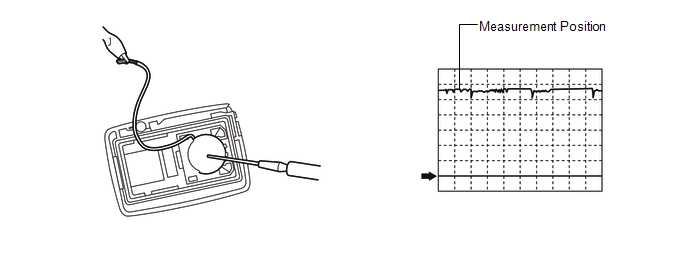
HINT:
When measuring the battery voltage, while operating the lock switch of a door
outside handle assembly, bring the key within the entry operating range to perform
the measurement. For the entry operating range, refer to System Description (See
page .gif) ).
).
Standard Voltage:
|
Item |
Content |
|---|---|
|
Tester Connection |
Battery positive (+) - Battery negative (-) |
|
Tool Setting |
0.5 V/DIV., 100 ms/DIV. |
|
Condition |
Engine switch off, all doors closed and lock switch pushed |
|
Specified Condition |
2.2 to 3.2 V (Refer to the waveform) |
| OK | .gif) |
REPLACE ELECTRICAL KEY TRANSMITTER |
| NG | .gif) |
REPLACE TRANSMITTER BATTERY |
|
7. |
CHECK WAVE ENVIRONMENT |
(a) Bring the key near the door control receiver, and check that the wireless function.
HINT:
- When the key is brought near the door control receiver, the possibility of wave interference decreases, and it can be determined if wave interference is causing the problem symptom.
- If the inspection result indicates that the problem only occurs in certain locations or times of day, the possibility of wave interference is high. Also, added vehicle components may cause wave interference. If installed, remove them and perform the operation check.
OK:
Wireless function operates normally.
| OK | .gif) |
AFFECTED BY WAVE INTERFERENCE |
|
|
8. |
CHECK POWER SOURCE |
(a) Check if functions other than the entry function operate when the engine switch is off.
|
Result |
Proceed to |
|---|---|
|
Other functions do not operate. |
A |
|
Other functions operate. |
B |
HINT:
Perform this check with using functions that do not require the engine switch to be on (ACC or IG) in order to operate.
| B | .gif) |
GO TO SMART KEY SYSTEM (for Start Function) (Proceed to How to Proceed with Troubleshooting) |
|
|
9. |
INSPECT FUSES (EFI NO. 1, ECU-B) |
(a) Remove the EFI NO. 1 and ECU-B fuses to the engine room relay block and junction block.
(b) Measure the resistance according to the value(s) in the table below.
Standard Resistance:
|
Tester Connection |
Condition |
Specified Condition |
|---|---|---|
|
EFI NO. 1 fuse |
Always |
Below 1 Ω |
|
ECU-B fuse |
Always |
Below 1 Ω |
| NG | .gif) |
REPLACE FUSE (EFI NO. 1, ECU-B) |
|
|
10. |
CHECK HARNESS AND CONNECTOR (CERTIFICATION ECU - BATTERY AND BODY GROUND) |
(a) Install the EFI NO. 1 and ECU-B fuses to the engine room relay block and junction block.
|
(b) Disconnect the certification ECU (smart key ECU assembly) connector. |
|
(c) Measure the voltage and resistance according to the value(s) in the table below.
Standard Voltage:
|
Tester Connection |
Condition |
Specified Condition |
|---|---|---|
|
D25-1 (+B) - Body ground |
Always |
11 to 14 V |
|
D25-17 (CUTB) - Body ground |
Always |
11 to 14 V |
Standard Resistance:
|
Tester Connection |
Condition |
Specified Condition |
|---|---|---|
|
D25-15 (E) - Body ground |
Always |
Below 1 Ω |
|
*1 |
Front view of wire harness connector (to Certification ECU (Smart Key ECU Assembly)) |
| NG | .gif) |
REPAIR OR REPLACE HARNESS OR CONNECTOR |
|
|
11. |
CHECK HARNESS AND CONNECTOR (CERTIFICATION ECU - DOOR CONTROL RECEIVER) |
|
(a) Disconnect the door control receiver assembly connector. |
|
(b) Measure the resistance according to the value(s) in the table below.
Standard Resistance:
|
Tester Connection |
Condition |
Specified Condition |
|---|---|---|
|
D26-5 (RC0) - M16-4 (+5) |
Always |
Below 1 Ω |
|
D26-15 (RDA) - M16-5 (DATA) |
Always |
Below 1 Ω |
|
D26-16 (RSSI) - M16-2 (RSSI) |
Always |
Below 1 Ω |
|
D26-5 (RC0) - Body ground |
Always |
10 kΩ or higher |
|
D26-15 (RDA) - Body ground |
Always |
10 kΩ or higher |
|
D26-16 (RSSI) - Body ground |
Always |
10 kΩ or higher |
|
M16-4 (+5) - Body ground |
Always |
10 kΩ or higher |
|
M16-5 (DATA) - Body ground |
Always |
10 kΩ or higher |
|
M16-2 (RSSI) - Body ground |
Always |
10 kΩ or higher |
|
*1 |
Front view of wire harness connector (to Certification ECU (Smart Key ECU Assembly)) |
|
*2 |
Front view of wire harness connector (to Door Control Receiver Assembly) |
| NG | .gif) |
REPAIR OR REPLACE HARNESS OR CONNECTOR |
|
|
12. |
CHECK HARNESS AND CONNECTOR (DOOR CONTROL RECEIVER - BODY GROUND) |
|
(a) Measure the resistance according to the value(s) in the table below. Standard Resistance:
|
|
| NG | .gif) |
REPAIR OR REPLACE HARNESS OR CONNECTOR |
|
|
13. |
INSPECT DOOR CONTROL RECEIVER ASSEMBLY (POWER SOURCE) |
(a) Reconnect the certification ECU (smart key ECU assembly) connector.
(b) Reconnect the door control receiver assembly connector.
|
(c) Measure the voltage according to the value(s) in the table below. Standard Voltage:
|
|
| NG | .gif) |
REPLACE CERTIFICATION ECU (SMART KEY ECU ASSEMBLY) |
|
|
14. |
INSPECT DOOR CONTROL RECEIVER ASSEMBLY (DOOR CONTROL RECEIVER SIGNAL OUTPUT) |
|
(a) Measure the voltage according to the value(s) in the table below. Standard Voltage:
|
|
| OK | .gif) |
REPLACE CERTIFICATION ECU (SMART KEY ECU ASSEMBLY) |
| NG | .gif) |
REPLACE DOOR CONTROL RECEIVER ASSEMBLY |
 Entry Answer-back Buzzer does not Sound
Entry Answer-back Buzzer does not Sound
DESCRIPTION
The smart key system uses the wireless door lock buzzer to perform various vehicle
exterior warnings. When the conditions for each warning are met, the certification
ECU (smart key EC ...
 All Door Entry Lock/Unlock Functions do not Operate, but Wireless Functions
Operate
All Door Entry Lock/Unlock Functions do not Operate, but Wireless Functions
Operate
DESCRIPTION
When the wireless door lock and unlock functions operate, the communication circuit
between the door lock receiver assembly and certification ECU (smart key ECU assembly)
is normal. W ...
Other materials about Toyota Venza:
Precaution
PRECAUTION
CAUTION:
Replace any faulty seat belt components (outer belt, inner belt, bolts, nuts,
adjustable shoulder anchor, tether anchor hardware and other related parts). When
inspecting a vehicle that was in a collision, be sure to check all of the ...
Radiator Grille
Components
COMPONENTS
ILLUSTRATION
Removal
REMOVAL
PROCEDURE
1. REMOVE COOL AIR INTAKE DUCT SEAL
2. REMOVE RADIATOR GRILLE
(a) Put protective tape around the radiator grille.
Text in Illustration
*1
...
Pressure Control Solenoid "B" Electrical (Shift Solenoid Valve SL2) (P0778)
DESCRIPTION
Changing from 1st to 6th is performed by the TCM turning shift solenoid valves
SL1, SL2, SL3, SL4 and SL on and off. If an open or short circuit occurs in any
of the shift solenoid valves, the TCM controls the remaining normal shift solenoid
...
0.1499

.gif)
.png)
